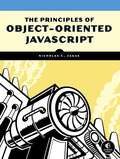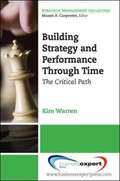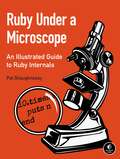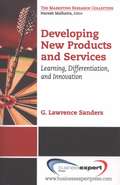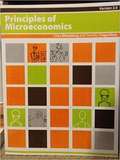Special Collections
Free Upskilling Books for All!
- Table View
- List View
The Principles of Object-Oriented JavaScript
by Nicholas C. ZakasIf you've used a more traditional object-oriented language, such as C++ or Java, JavaScript probably doesn't seem object-oriented at all.
It has no concept of classes, and you don't even need to define any objects in order to write code. But don't be fooled—JavaScript is an incredibly powerful and expressive object-oriented language that puts many design decisions right into your hands.In The Principles of Object-Oriented JavaScript, Nicholas C. Zakas thoroughly explores JavaScript's object-oriented nature, revealing the language's unique implementation of inheritance and other key characteristics.
You'll learn:–The difference between primitive and reference values–What makes JavaScript functions so unique–The various ways to create objects–How to define your own constructors–How to work with and understand prototypes–Inheritance patterns for types and objectsThe Principles of Object-Oriented JavaScript will leave even experienced developers with a deeper understanding of JavaScript.
Unlock the secrets behind how objects work in JavaScript so you can write clearer, more flexible, and more efficient code.
Money and Banking
by Robert E. WrightThe financial crisis of 2007-8 has already revolutionized institutions, markets, and regulation. Wright's Money and Banking V 2.0 captures those revolutionary changes and packages them in a way that engages undergraduates enrolled in Money and Banking and Financial Institutions and Markets courses.
Building Strategy and Performance
by Kim WarrenThe fundamental challenge facing business leaders is to drive performance into the future--the dynamics of strategy. To tackle this effectively, they need a clear understanding of what causes performance to improve or deteriorate and what power they have to change this trajectory for the better. Without this understanding, they risk making poor choices about their future--failing to exploit promising opportunities, pursuing unachievable aims, or falling victim to competitive and other threats. Building Strategy and Performance Through Time sets the agenda for building business strategy in powerful, actionable, and accessible terms. It gives executives clear frameworks for answering three fundamental questions: * Why is our business performance following its current path? * Where is it going if we carry on as we are? * How can we design a robust strategy to transform this future? The existing strategy tools most widely used help guide management's choices about where to compete--which customers to serve, with what products and services, and how to deliver those products and services to those customers effectively and profitably. While this choice is important, it is not often changed in any fundamental way; having found a reasonably strong and profitable position on these issues, few firms will, or should, set off in a new direction. But there is still much to be done to deliver that strategy, powerfully and sustainably over time. Many decisions need to be made, continually and holistically, across all functions of the business and adapted as conditions change from month to month and year to year. Pricing, product development, marketing, hiring, service levels, and other decisions cannot be made in isolation but must take into account other choices being made, elsewhere and at different times. Building Strategy and Performance Through Time explains a reliable, practical method, known as strategy dynamics, that creates a living picture of how an enterprise actually works and delivers performance. This picture shows exactly where the levers are that management controls and how to choose what to do, when, and how much, to accomplish your specific goals. It shows, too, how the same approach can be used to defeat competitors, cope with other outside forces, and keep delivering performance.
Sexuality and Our Diversity
by Marcus TyeSexuality and Our Diversity: Integrating Culture with the Biopsychosocial by Marcus Tye explores, with an integrated approach, the complex dimensions of biology, culture, psychology, sociology, history, and philosophy that explain human sexual diversity. While this text is primarily focused on the present, it also explores selected aspects of history to lend perspective to students that contemporary controversies have deep historical roots.
International Finance
by Steve SuranovicInternational Finance Theory and Policy is built on Steve Suranovic's belief that to understand the international economy, students need to learn how economic models are applied to real world problems. It is true what they say, that "economists do it with models." That's because economic models provide insights about the world that are simply not obtainable solely by discussion of the issues. International Finance Theory and Policy develops a unified model of the international macroeconomy. The text provides detailed descriptions of major macroeconomic variables, covers the interest rate parity and purchasing power parity theories of exchange rate determination, takes an exhaustive look at the pros and cons of trade imbalances and presents the well-known AA-DD model to explore the effects of fiscal and monetary policy under both fixed and flexible exchange rates. The models are developed, not by employing advanced mathematics, but rather by walking students through a detailed description of how a model's assumptions influence its conclusions. But more importantly, each model and theory is connected to real world policy issues. The Finance Text has the following unique features: o Begins with an historical overview of the international macroeconomy to provide context for the theory. o Concludes with a detailed discussion of the pros and cons of fixed and floating exchange rate systems. o Provides an extensive look at the issue of trade imbalances. Readers learn techniques to evaluate whether a country's trade deficit (or surplus) is dangerous, beneficial, or benign. o Explains how purchasing power parity is used to make cross country income comparisons. o Offers clear detailed explanations of the AA-DD model. o Applies the AA-DD model to understand the effects of monetary and fiscal policy on GDP, the exchange rate, and the trade balance.
Criminal Law
by Lisa StormIf you ask Lisa Storm, she'll say, "Let's face it, legal textbooks can be dry." She'll also tell you what you already know, "This is unfortunate because law, especially criminal law, is an intrinsically compelling topic." That is why she employs the "applied approach" (and takes it to a new level) to hold your students' attention and keep them alert. Criminal Law employs a variety of instructional techniques which will engage your students from start to finish. First, every chapter contains embedded videos, ethical scenarios, charts, diagrams, and/or tables to demonstrate the legal concepts and examples provided. These enhancements break up the text and also appeal to various learning styles.
eMarketing
by Rob Stokes and the Minds of QuirkeMarketing: The Essential Guide to Online Marketing by Rob Stokes, a marketing guru and CEO of Quirk eMarketing, Sarah Blake, and his team of QuirkStars, consolidates 11 years of real marketing experience doing online marketing at Quirk into a full length textbook that draws on both academic theory and practical experience. It is intended for third and fourth year marketing students, this textbook covers all of the important aspects of online marketing, including chapters on each of the following areas: * Search Engine Marketing * Affiliate Marketing * Web Analytics and Conversion Optimisation * Web Development * Online Copywriting * Online Advertising * WebPR * Online Reputation Management * Pay Per Click Advertising * Viral Marketing * Social Media Marketing * Search Engine Optimisation * eMarketing Strategy * Market Research * Mobile Marketing * Crowdsourcing * Customer Relationship Management It also features a glossary and index as well as summaries, learning objectives and discussion points for each chapter. This eMarketing textbook offers students information that is highly applicable with examples to which they can easily relate. It is a must-have guide for each and every undergraduate and post-graduate marketing student as well as anyone working in the digital or traditional marketing sphere.
Principles of Managerial Economics
by Donald N. StengelEconomic principles inform good business decision making. Although economics is sometimes dismissed as a discourse of practical relevance to only a relatively small circle of academicians and policy analysts who call themselves economists, sound economic reasoning benefits any manager of a business, whether they are involved with production and operations, marketing, finance, or corporate strategy. Along with enhancing decision making, the field of economics provides a common language and framework for comprehending and communicating phenomena that occur within a business, as well as between a business and its environment. This text addresses the core of a subject commonly called managerial economics, which is the application of microeconomics to business decisions. Key relationships between price, quantity, cost, revenue, and profit for an individual firm are presented in the form of simple conceptual models. The text includes key elements from the economics of consumer demand and the economics of production. The book discusses economic motivations for expanding a business and contributions from economics for improved organization of large firms. Market price-quantity equilibrium, competitive behavior, and the role of market structure on market equilibrium and competition are addressed. Finally, the text considers market regulation in terms of the generic problems that create the need for regulation and possible remedies for those problems. Although the academic literature of managerial economics often employs abstract mathematics and large corporations create and use sophisticated mathematical models that apply economics, this book focuses on concepts, terminology, and principles, with minimal use of mathematics. The reader will gain a better understanding of why businesses and markets function as they do and how those institutions can function better.
Principles of Social Psychology
by Charles StangorHave you ever had trouble teaching the various topics of social psychology and fitting them together to form a coherent field? Dr. Stangor said he felt like he was presenting a laundry list of ideas, research studies, and phenomena, rather than an integrated set of principles and knowledge. He felt like this was not only hard for him, but even more challenging for his students. He wondered how they could be expected to remember and understand all of the many phenomena that we social psychologists study? And how could they tell what was most important? It was then that he realized a fresh approach to a Social Psychology textbook was was needed to structure and integrate their learning; thus, Principles of Social Psychology was born.
Introduction to Psychology
by Charles StangorWhen you teach Introduction to Psychology, do you find it difficult — much harder than teaching classes in statistics or research methods? Do you easily give a lecture on the sympathetic nervous system, a lecture on Piaget, and a lecture on social cognition, but struggle with linking these topics together for the student? Do you feel like you are presenting a laundry list of research findings rather than an integrated set of principles and knowledge? Have you wondered how to ensure your course is relevant to your students? If so, then you have something in common with Charles Stangor. Charles Stangor's Introduction to Psychology utilizes the dual theme of behavior and empiricism to make psychology relevant to intro students. Charles wrote this book to help students organize their thinking about psychology at a conceptual level. Five or ten years from now, he does not expect his students to remember the details of most of what he teaches them.
Essentials of Nutrition
by Maureen Zimmerman and Beth SnowEssentials of Nutrition: A Functional Approach, by Zimmerman and Snow is a textbook aimed at non-majors for the nutrition course. With this text your students will examine some of the popular myths about nutrition and will develop a foundation for making smart dietary choices and to debunk these common nutrition myths. As students learn about the role of nutrition in optimal health, they will learn about dietary nutrients and toxicants. A sampling of topics covered include macro- and micronutrient needs; determining individual nutrient and caloric needs; digestion and absorption; nutritional needs throughout the various stages of human development; and current food issues, sustainability concerns, including food safety.
Personal Finance
by Rachel Siegel and Carol YachtPersonal Finance by Rachel Siegel and Carol Yacht is a comprehensive Personal Finance text which includes a wide range of pedagogical aids to keep students engaged and instructors on track. If you would like to hear Rachel talk about her book, and the Personal Finance course listen here to her podcast. This book is arranged by learning objectives. The headings, summaries, reviews, and problems all link together via the learning objectives. This helps instructors to teach what they want, and to assign the problems that correspond to the learning objectives covered in class. Personal Finance includes personal finance planning problems with links to solutions, and personal application exercises, with links to their associated worksheet(s) or spreadsheet(s). In addition, the text boasts a large number of links to videos, podcasts, experts' tips or blogs, and magazine articles to illustrate the practical applications for concepts covered in the text. Finally, the modular nature of the chapters lends itself to the Flat World Knowledge publishing model allowing instructors to adapt the textbook to the exact needs of their specific class and student body.
Ruby Under a Microscope
by Pat ShaughnessyRuby is a powerful programming language with a focus on simplicity, but beneath its elegant syntax it performs countless unseen tasks.
Ruby Under a Microscope gives you a hands-on look at Ruby’s core, using extensive diagrams and thorough explanations to show you how Ruby is implemented (no C skills required). Author Pat Shaughnessy takes a scientific approach, laying out a series of experiments with Ruby code to take you behind the scenes of how programming languages work.
You’ll even find information on JRuby and Rubinius (two alternative implementations of Ruby), as well as in-depth explorations of Ruby’s garbage collection algorithm.
Ruby Under a Microscope will teach you:–How a few computer science concepts underpin Ruby’s complex implementation–How Ruby executes your code using a virtual machine–How classes and modules are the same inside Ruby–How Ruby employs algorithms originally developed for Lisp–How Ruby uses grammar rules to parse and understand your code–How your Ruby code is translated into a different language by a compilerNo programming language needs to be a black box.
Whether you’re already intrigued by language implementation or just want to dig deeper into Ruby, you’ll find Ruby Under a Microscope a fascinating way to become a better programmer. Covers Ruby 2.x, 1.9 and 1.8
Introductory Statistics
by Douglas S. Shafer and Zhiyi ZhangIn many introductory level courses today, teachers are challenged with the task of fitting in all of the core concepts of the course in a limited period of time. The Introductory Statistics teacher is no stranger to this challenge. To add to the difficulty, many textbooks contain an overabundance of material, which not only results in the need for further streamlining, but also in intimidated students. Shafer and Zhang wrote Introductory Statistics by using their vast teaching experience to present a complete look at introductory statistics topics while keeping in mind a realistic expectation with respect to course duration and students' maturity level. Over time the core content of this course has developed into a well-defined body of material that is substantial for a one-semester course. Shafer and Zhang believe that the students in this course are best served by a focus on that core material and not by an exposure to a plethora of peripheral topics. Therefore in writing Introduction to Statistics they have sought to present only the core concepts and use a wide-ranging set of exercises for each concept to drive comprehension. As a result Introduction to Statistics is a smaller and less intimidating textbook that trades some extended and unnecessary topics for a better-focused presentation of the central material.
An Introduction to Politics
by T. M. SellThis textbook introduces students to the field of Political Studies. An Introduction to Politics is a little more brief, concise and in-between than similar textbooks currently on the market. Because this is usually a first-year course, overloading a textbook with too much minutiae of the ins and outs of politics can lead to students giving up on the book. Politics is a great story - the story of human existence. A successful textbook needs to tell that story.
Developing New Products and Services
by G. Lawrence SandersThe focus of the book is on the up-front activities and ideas for new product and service development. A central theme of this book is that there is, or should be, a constant struggle going on in every organization, business, and system between delivering feature-rich versions of products and services using extravagant engineering and delivering low-cost versions of products and services using frugal engineering. Delivering innovative products is accomplished by an endless cycle of business planning, creative and innovative insight, and learning-about and learning-by-doing activities. A number of powerful concepts and tools are presented in the book to facilitate new product development. For example, three templates are presented that facilitate new product and service development. The FAD (features, attributes, and design) template is used to identify the features and attributes that can be used for product and service differentiation. The Ten-Ten planning process contains two templates: an Organizational and Industry Analysis template and the Business Plan Overview template. These two templates coupled with the FAD template can be used to develop a full-blown business plan. Entrepreneurship, technology and product life cycles, product and service versioning, product line optimization, creativity, lock-in real options, business valuation, and project management topics are also covered.
Developing New Products and Services
by G. Lawrence SandersThe focus of the book is on the up-front activities and ideas for new product and service development. A central theme of this book is that there is, or should be, a constant struggle going on in every organization, business, and system between delivering feature-rich versions of products and services using extravagant engineering and delivering low-cost versions of products and services using frugal engineering. Delivering innovative products is accomplished by an endless cycle of business planning, creative and innovative insight, and learning-about and learning-by-doing activities. A number of powerful concepts and tools are presented in the book to facilitate new product development. For example, three templates are presented that facilitate new product and service development. The FAD (features, attributes, and design) template is used to identify the features and attributes that can be used for product and service differentiation. The Ten-Ten planning process contains two templates: an Organizational and Industry Analysis template and the Business Plan Overview template. These two templates coupled with the FAD template can be used to develop a full-blown business plan. Entrepreneurship, technology and product life cycles, product and service versioning, product line optimization, creativity, lock-in real options, business valuation, and project management topics are also covered.
Principles of Microeconomics Version 2.0
by Libby Rittenberg and Timothy TregarthenFlat World Knowledge is honored to publish Version 2.0 (an orginal re-launch) of Tim Tregarthen's wonderful principles of microeconomics book, and proud to bring Tim's incredible talents as a teacher back to life so future generations of students can continue to learn from him.
Principles of Macroeconomics
by Libby Rittenberg and Timothy TregarthenFlat World Knowledge is honored to publish a new, first edition re-launch of Tim Tregarthen's wonderful principles of macroeconomics book, and proud to bring Tim's incredible talents as a teacher back to life so future generations of students can continue to learn from him. In 1996, he published the first edition of his principles of microeconomics textbook to great acclaim, and it became widely used in colleges around the country. That same year, MS made him wheelchair-bound. The disease forced his retirement from teaching at the University of Colorado at Colorado Springs in 1998. He lost the use of his arms in 2001 and has been quadriplegic ever since. Tim never let his disease get him down. In fact, he turned back to his love of writing and teaching for inspiration. He obtained a voice-activated computer, recruited a co-author, Libby Rittenberg of Colorado College, and turned his attention to revising his principles of economics book. Today we are excited to introduce Libby Rittenberg and Timothy Tregarthen's Principles of Macroeconomics. The authors teach economics as the study of "choice " by providing students with an accessible, straightforward overview of economics. This text combines the clarity and writing of Tregarthen's seminal periodical "The Margin" with great teaching insights. Rittenberg and Tregarthen help students to understand how real individuals actually work with economics. In this new book, the authors illustrate the practicality and relevance of economics with a variety of new illustrations and insights. The authors take a three-pronged approach to every concept: (1) the concept is covered with a "Heads Up" to ward off confusion, (2) a "You Try It" section makes sure students are staying on top of the concept and (3) a "Case and Point" section that uses a real-world application to harness the concept in reality. For one example of how this plays out in the text see "Chapter 3, Section 2 on Supply".here This book is intended for a one-semester course in Macroeconomics taught out the social sciences or business school.
Principles of Economics Version 2.0
by Libby Rittenberg and Timothy TregarthenIn the macro chapters of Version 2.0 of Principles of Economics thoroughly incorporates the recent recession and recovery-- placing it in historical and theoretical context and not shying away from the controversies surrounding how government responded to it. In the micro chapters, all the time-sensitive data has been updated, along with over half of all the "Start Ups" and "Case and Point" applications being brand new or updated. Flat World Knowledge is thrilled to publish a re-launch of Tim Tregarthen's acclaimed Principles of Economics V. 2.0 book, and proud to bring Tim's remarkable talents as a teacher to future generations of students.
The Power of Selling
by Kim RichmondThe Power of Selling is the perfect textbook to teach students about the proven process of selling. More important, it teaches students how to apply the tenets of selling to how to sell themselves and get the job they want, with the same process professional sales people learn (or brush up) on their own selling skills. What makes someone successful in sales? Are great sales people born or made? Is there one magic selling process, or does the process change based on the business...or the customer? How can the selling process really come alive for students in the classroom? How do students learn how to sell for life, not just for a course? The Power of Selling by Kim Richmond answers these questions and makes the principles of selling come alive. Kim looks at the topic of selling through a different lens, and provides inspiration and ideas. The Power of Selling provides an exciting and interactive experience for both professors and students through the use of 4 unique elements: 1. Content The content is based on the core selling tenets so instructors will find the familiar principles of selling. In addition, the impact of Sales 2.0 is addressed at every stage including how to use interactive tools such as Twitter, LinkedIn, Facebook, blogs, and wikis effectively. 2. Selling U The last section of each chapter is called Selling U. It applies the concepts covered in the chapter to a student's job search. Selling U topics include how to think about yourself as a brand, how to create a powerful cover letter and resume, how to create your personal elevator pitch, how to use networking and informational interviews to get the word out about your brand, how to prepare and dress for an interview, and how to negotiate and accept the right job offer. What makes The Power of Selling different is that Selling U is integrated into every chapter, which makes this text the ultimate guide to selling yourself. 3. Video Resources Videos are used throughout the book. Additional videos that are not included in the text are available for instructor use. Here are videos that are available: * Video Ride-alongs - One of the best ways to learn about sales is by going on ride-alongs. So every chapter starts with an exclusive feature called a Video Ride-along. These short videos feature seven different sales professionals - one that starts each chapter. Each one talks about how he or she applies one of the key concepts covered in the chapter in their job. These videos are designed to be "virtual ride-alongs" so the students can actually feel as though they are getting insights first hand from selling professionals. * The Power of Selling YouTube Channel here (youtube.com/thepowerofselling) - Over 50 videos are included featuring the sales professionals who are highlighted in the Video Ride-alongs. About half of the videos are used in the textbook. The balance are available for instructor use. Several are included in Video Learning Segments (see below). These videos are excellent resources for use in the classroom, exercises, and assignments. * Video Learning Segments In addition to the traditional supplements of Instructor Manual, PowerPoints, and Test Bank, there are also Video Learning Segments. These are PowerPoint slides embedded with videos designed to supplement the course PowerPoints and focus on one concept, like an ethical dilemma, pre-call preparation, or effective presentations, how to use email effectively. Each segment includes slides, videos, discussion questions, or exercises. 4. The Power of Selling LinkedIn Group. here This group was created on LinkedIn.com expressly as a resource for the faculty and students who use this textbook. The group includes sales professionals from across the country and from different industries. This is a great tool for faculty and students alike to network, participate in discussions, ask questions, and connect with "real world" selling professionals.
Intermediate Algebra
by John ReddenIt is essential to lay a solid foundation in mathematics if a student is to be competitive in today's global market. The importance of algebra, in particular, cannot be overstated, as it is the basis of all mathematical modeling used in applications found in all disciplines. Traditionally, the study of algebra is separated into a two parts, Elementary and Intermediate Algebra. This textbook by John Redden, Intermediate Algebra, is the second part. Written in a clear and concise manner, it carefully builds on the basics learned in Elementary Algebra and introduces the more advanced topics required for further study in applications found in most disciplines. Used as a standalone textbook, Intermediate Algebra offers plenty of review as well as something new to engage the student in each chapter. Written as a blend of the traditional and graphical approaches to the subject, this textbook introduces functions early and stresses the geometry behind the algebra. While CAS independent, a standard scientific calculator will be required and further research using technology is encouraged.
Elementary Algebra
by John ReddenIt is essential to lay a solid foundation in mathematics if a student is to be competitive in today's global market. The importance of algebra, in particular, cannot be overstated as it is the basis of all mathematical modeling used in applications found in all disciplines. Traditionally, the study of algebra is separated into a two parts, Elementary and Intermediate Algebra. This textbook by John Redden, Elementary Algebra, is the first part written in a clear and concise manner, making no assumption of prior algebra experience. It carefully guides students from the basics to the more advanced techniques required to be successful in the next course.
Principles of Marketing version 2.0
by Jeff Tanner and Mary Anne RaymondPrinciples of Marketing Version 2.0 by Tanner and Raymond teaches the experience and process of actually doing marketing - not just the vocabulary. It carries five dominant themes throughout in order to expose students to marketing in today's environment:
Research Methods in Psychology
by Paul C. PriceYears before this book was a Flat World Knowledge textbook, Paul Price wrote an extensive series of handouts to replace the textbook he had been using for his psychological research methods course, and he posted them online for his students. The advantages of this were that 1) students had a streamlined presentation of the most important methodological concepts in psychology, and 2) they could access it online for free. Paul turned his book into a proper textbook by having it reviewed, edited and published with the full set of ancillaries by Flat World Knowledge so not only could his students get the materials for free, but so could yours. Although the content of Research Methods in Psychology is fairly traditional--making it easy for you to use with your existing courses--it also emphasizes a fundamental idea that is often lost on undergraduates: research methods are not a peripheral concern in our discipline; they are central. This why the overarching goal of this textbook is to present the basics of psychological research methods--focusing on the concepts and skills that are most widely shared within the discipline--emphasizing both their centrality to our field and their contribution to our understanding of human behavior. The book will include several features that will help accomplish this overarching goal. The Core Concepts: Dr. Price based his choices about content and terminology on the most influential original books and articles in the research methodology literature--as determined by an empirical analysis of the reference lists of secondary sources. He also relied on the Undergraduate Psychology Major Learning Goals and Outcomes document commissioned by the APA. Although many of the research methods outcomes in that document are addressed in all research methods textbooks (e.g., "Describe how various research designs address different types of questions and hypotheses"), others are rarely mentioned (e.g., "Recognize the limitations of applying normative conclusions to individuals"). The Examples: The text includes examples drawn from the entire range of contemporary psychology, including abnormal, clinical, and counseling psychology. Dr. Price also chose examples to show how psychological research has fundamentally changed what we believe to be true about human behavior (for example, in the area of eyewitness memory). The Style: Dr. Price concentrated on making the style of this book both straightforward and engaging. If you are looking for a new research methods textbook for your psychology course that has been used by "teachers" and is thorough in its content, you will find your book in Paul Price's Research Methods in Psychology. Order a desk copy and see for yourself.
